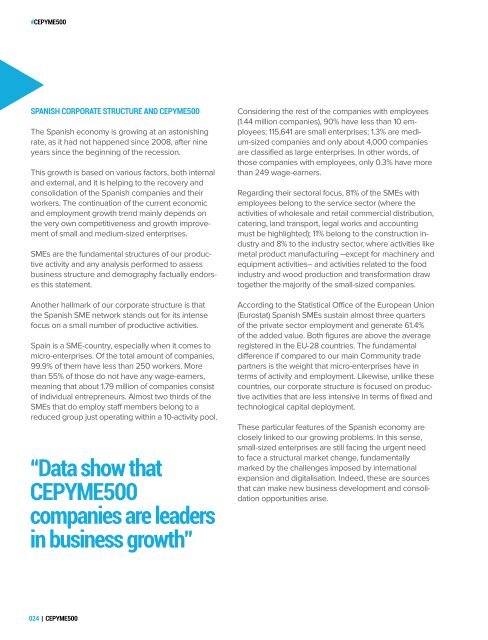Create successful ePaper yourself
Turn your PDF publications into a flip-book with our unique Google optimized e-Paper software.
#<strong>CEPYME500</strong><br />
SPANISH CORPORATE STRUCTURE AND <strong>CEPYME500</strong><br />
The Spanish economy is growing at an astonishing<br />
rate, as it had not happened since 2008, after nine<br />
years since the beginning of the recession.<br />
This growth is based on various factors, both internal<br />
and external, and it is helping to the recovery and<br />
consolidation of the Spanish companies and their<br />
workers. The continuation of the current economic<br />
and employment growth trend mainly depends on<br />
the very own competitiveness and growth improvement<br />
of small and medium-sized enterprises.<br />
SMEs are the fundamental structures of our productive<br />
activity and any analysis performed to assess<br />
business structure and demography factually endorses<br />
this statement.<br />
Another hallmark of our corporate structure is that<br />
the Spanish SME network stands out for its intense<br />
focus on a small number of productive activities.<br />
Spain is a SME-country, especially when it comes to<br />
micro-enterprises. Of the total amount of companies,<br />
99.9% of them have less than 250 workers. More<br />
than 55% of those do not have any wage-earners,<br />
meaning that about 1.79 million of companies consist<br />
of individual entrepreneurs. Almost two thirds of the<br />
SMEs that do employ staff members belong to a<br />
reduced group just operating within a 10-activity pool.<br />
“Data show that<br />
<strong>CEPYME500</strong><br />
companies are leaders<br />
in business growth”<br />
Considering the rest of the companies with employees<br />
(1.44 million companies), 90% have less than 10 employees;<br />
115,641 are small enterprises; 1.3% are medium-sized<br />
companies and only about 4,000 companies<br />
are classified as large enterprises. In other words, of<br />
those companies with employees, only 0.3% have more<br />
than 249 wage-earners.<br />
Regarding their sectoral focus, 81% of the SMEs with<br />
employees belong to the service sector (where the<br />
activities of wholesale and retail commercial distribution,<br />
catering, land transport, legal works and accounting<br />
must be highlighted); 11% belong to the construction industry<br />
and 8% to the industry sector, where activities like<br />
metal product manufacturing –except for machinery and<br />
equipment activities– and activities related to the food<br />
industry and wood production and transformation draw<br />
together the majority of the small-sized companies.<br />
According to the Statistical Office of the European Union<br />
(Eurostat) Spanish SMEs sustain almost three quarters<br />
of the private sector employment and generate 61.4%<br />
of the added value. Both figures are above the average<br />
registered in the EU-28 countries. The fundamental<br />
difference if compared to our main Community trade<br />
partners is the weight that micro-enterprises have in<br />
terms of activity and employment. Likewise, unlike these<br />
countries, our corporate structure is focused on productive<br />
activities that are less intensive in terms of fixed and<br />
technological capital deployment.<br />
These particular features of the Spanish economy are<br />
closely linked to our growing problems. In this sense,<br />
small-sized enterprises are still facing the urgent need<br />
to face a structural market change, fundamentally<br />
marked by the challenges imposed by international<br />
expansion and digitalisation. Indeed, these are sources<br />
that can make new business development and consolidation<br />
opportunities arise.<br />
024 | <strong>CEPYME500</strong>

















